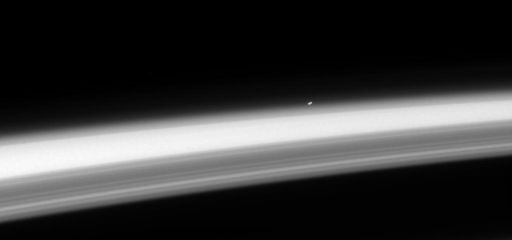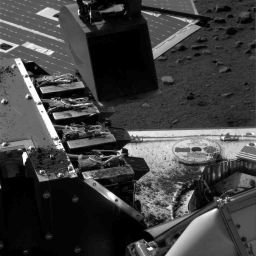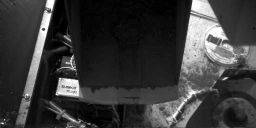Emily Lakdawalla • Jun 23, 2008
What's up in the solar system for the week of June 23
Let's check in on what's going on with our trusty robots around the solar system.Cassini continues its stable once-per-week orbits of Saturn; it just this morning passed periapsis (its closest approach) of Rev 73, crossing to the sunlit side of the rings. With the once-per-week orbits periapsis happens on Mondays and apoapsis on Thursdays. The next scheduled close flyby of a moon doesn't happen until July 31, but a distant Titan flyby will happen on Saturday. Raw images are mostly shots of Saturn and rings, with not a lot of moon views. Saturn is showing some wild and crazy atmospheric patterns, like in this raw image. The imaging team released some nice pictures of Janus, Dione, and Rhea last week, but my favorite was the one below, showing two stars of the Alpha Centauri system just about to disappear behind Saturn. Saturn is currently 1,500 million kilometers from Earth. Alpha Centauri is 41 million million kilometers from Earth. As far away as Cassini is from us, it's really no closer to the nearest star systems than we are.

NASA / JPL / SSI
Alpha Centauri as seen from Saturn
Cassini captured both of the stars in the Alpha Centauri system just before they dipped behind Saturn's cloud tops in this photo from May 17, 2008. Alpha Centauri is one of the star systems nearest to our own (it's the closest visible naked-eye star), but it is still more than four light-years away from us. At the time that the photo was taken, Cassini was poised high above Saturn's north pole, looking across Saturn's sunlit limb at a spot near its equator. The rings -- not visible in this image -- cast shadows across the low latitudes of the northern hemisphere, making the striped patterns across the bottom of the image, which would otherwise be sunlit. Cassini's camera resolves the two brightest stars of the Alpha Centauri system, Alpha Centauri A and B, as separate dots; a third star, Alpha Centauri C, is not visible in this photo.On the surface of Mars, it is late autumn in the southern hemisphere (Ls 89°). The southern winter solstice happens on Wednesday, bringing the rovers their shortest winter day and lowest Sun for the year. At its northern location, Phoenix will see summer solstice, and will enjoy the highest sun and longest day of its entire mission. This time around, cosmic coincidence has placed Mars' northern summer solstice only four days after Earth's -- but since Mars years are 687 days long to Earth's 365, the coincidence won't happen again next year. I've been forgetting to check the weekly Mars weather reports from MARCI; but weather has lately been benign at all three landing sites.
Today is sol 1,590-1 for Spirit and sol 1,569-70 for Opportunity. Spirit is still parked on the edge of Home Plate, in the same position it has occupied since sol 1,464 (February 15), with its solar cells pointed northward toward the weak winter sun. Opportunity has made a lot of progress toward Cape Verde in the past week.
It's sol 27-28 for Phoenix. Phoenix successfully delivered a sample from the Wonderland area to the Optical Microscope on Saturday (sol 26), and managed to leave enough soil in the scoop to deliver a sample from the same location to the wet chemistry laboratory and to TEGA. This would be the first delivery to the wet chemistry lab. It seems there was a hiccup on sol 27 (Sunday) as no images were returned that day and Mark Lemmon comments on his raw images website that they had to "exit safe mode" that day -- I have no further information on what this means. But they seem to have dealt with whatever problem it was effectively, because they are returning a bonanza of images from sol 28 -- nearly 200 of them already, and only two of them from the robotic arm camera, so I assume there's more in the pipeline. (My robotic arm camera image page is updated to sol 26 but not sol 28 yet; I'll wait to see if more images come down.) Included in the sol 28 bonanza is the image below, which shows the robotic arm scoop poised over the MECA instrument, including the wet chemistry laboratory; I am not sure whether it documents a delivery of a sample to the wet chemistry lab or not. It does, however, document that yet more dirt has been dropped on the DVD!

NASA / JPL / UA / Texas A & M
The Phoenix DVD gets even dirtier
On sol 28 (June 22, 2008), Phoenix used the scoop on its robotic arm to bring a sample of soil from the Snow White / Rose Red trench to the first of its four wet chemistry laboratory cells (though I'm not sure whether a sample was delivered). In recent days it has spilled more dirt on the lander deck, including on top of the Phoenix DVD.There seems to have been a hiatus in Mars Reconnaissance Orbiter releases last week, but maybe they're just taking a break after their massive release to the Planetary Data System. The theme from Mars Odyssey this week was dunes and channels. This image is particularly cool, containing lava channels crosscut by faults -- the channels must have happened first, and then the faulting, and then nothing further happened, freezing the landscape for geologists to interpret and enjoy. On Earth such crosscutting relationships are usually hidden by the further effects of water erosion and vegetation cover; but everything on Mars is open and exposed for us to see. It's really a geologist's playground. There hasn't been anything new from Mars Express since I last checked.
At the Moon, Chang'e 1 and Kaguya are currently in orbit; there wasn't anything new from either mission last week. At Venus, Venus Express is currently in orbit; there wasn't anything new released from them last week either.MESSENGER is cruising toward its second encounter with Mercury on October 6, 105 days away. It is 120 million kilometers from Earth and 129 million kilometers from Mercury. They released two dramatically lit views of Mercury last week, one from before closest approach and one after. The "after" one really reminds me of the Moon.
Out in space, New Horizons is beyond Saturn, is 9.2 AU from Earth and 21.3 AU from Pluto. Last week whoever is responsible for these things released a slew of Voyager Weekly Status Reports documenting the Voyager 1 and 2 missions up to May 9 (the previous release had taken them through March 28). These reports contain interesting information on their position and the status of their consumables. As of May 9, Voyager 1 was 15.897 billion km from the Sun, Voyager 2 12.842 billion.
Rosetta is fast approaching its flyby of the asteroid Steins, on September 5, 2008; that's less than three months away! It will fly by steins at a distance of 800 kilometers at 18:33:57 UT on September 5. It will approach Steins from its night side and depart on the sunlit side, passing through zero (full) phase at a pretty close distance of 1,280 kilometers. Many of the instruments will be active, including of course the cameras; I will poke around to see what more I can find about flyby plans. In the meantime, this thread on unmannedspaceflight.com contains discussion about the flyby (thanks to member IM4 for the information in this summary).Dawn, Deep Impact, Hayabusa, and Stardust are all in cruise mode, talking to Earth from time to time; Genesis is in hibernation.


 Explore Worlds
Explore Worlds Find Life
Find Life Defend Earth
Defend Earth


